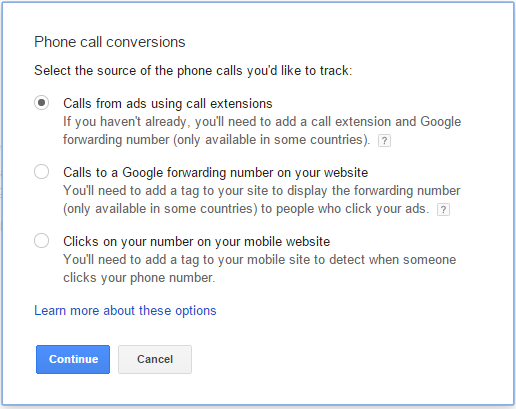Bruce Clay's Blog, page 30
April 20, 2015
Google’s New Mobile Breadcrumb URLs: Making the Most of Your Site Name & URL Structure
Google’s New Mobile Breadcrumb URLs: Making the Most of Your Site Name & URL Structure was originally published on BruceClay.com, home of expert search engine optimization tips.
Two more changes are coming to Google mobile search results, the search engine announced last week — this time to the way URLs are displayed.
Mobile search results no longer show the actual page URL, but instead show a breadcrumbs-like format of the URL structure. This is rolling out worldwide.
The breadcrumbs-like information can show the site name in place of the domain name. This is rolling out in the U.S. only for now.
These before and after examples from Google’s announcement post on the Google Webmaster Central blog show what’s changing:
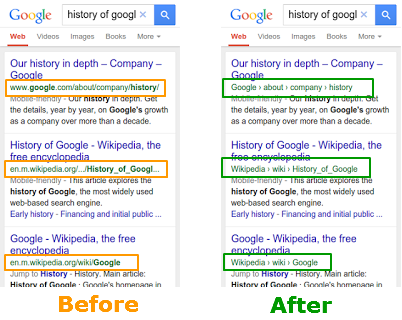
URL structure replaced by breadcrumb format in Google mobile search results
The change replaces a SERP result’s URL with a description of the page’s location in a “breadcrumbs-like format.” The exciting part of this announcement for online marketers is that you can control your displayed breadcrumb URLs and site name using Schema.org structured data. Google’s Gary Illyes gave an enthusiastic explanation:

Google Webmaster Trends Analyst Gary Illyes shares the news.
Change #1: Breadcrumbs Format instead of URL Structure
Google now displays the breadcrumbs-like format instead of URLs in mobile search results, period. The search engine has been testing this formatting for years in web and mobile search, and they’ve decided to implement it worldwide for mobile searches. Therefore, whether your site has marked up its pages with structured data or not, Google shows a breadcrumb format in place of your URL structure.
You can specifically control how the breadcrumb URL appears if you add Schema.org markup to the HTML on your pages. Refer to Schema.org’s breadcrumbs structured data for details; you can also find instructions in Google Developers Help, although at the time of this writing, the page was not up-to-date:

A Google Developers reference for Breadcrumb structured data markup can be found here: https://developers.google.com/structu....
But what if you don’t (yet) have schema markup on your site? Without structured URL data to refer to, Google will display whatever structure it feels best represents the way that page fits in your site. Google primarily bases this on:
Actual page URL, and/or
Breadcrumb navigation on the page
Well Structured URLs for the Win
Google looks for clues starting with the page URL itself. If you have organized your website content in a physical silo structure, with folders arranged in a logical way, then you have a big advantage. Even your naked URLs reveal a lot of information. As a best practice, the directories leading to your page should communicate a clear idea of what your page is about, both to the search engines who crawl your URL path and to visitors who see the URL in their browser address bar.
For example, compare the well-structured URL (top) to the flat directory structure below it:
com/engine-parts/cooling/audi-a6-quattro-engine-timing-belt-kit.html
com/cooling-audi-a6-quattro-engine-timing-belt-kit.html
Notice how, in the first URL, the folders “engine-parts” and “cooling” provide context for the name of this product page. We know that this product falls within the category of engine parts used for cooling.
A well-structured URL doesn’t have to be many levels deep to communicate what a page is all about. In fact, keeping pages within a few clicks of the home page is a recommended SEO best practice (three to five clicks deep is a good maximum guideline, though very large sites may need more). Flattening your URLs so that everything is on one level, as in the second URL above, creates chaos. There are many reasons to have structured URLs versus a flat directory structure, and Google’s latest announcement adds another reason to the list.
Breadcrumb Navigation Leads to SEO Success
Does your site have breadcrumb navigation links at the top of each page? Those little links help search engines understand your site structure in a powerful way. Breadcrumb links pass link equity within your site to reinforce your silo strategy. Showing a logical breadcrumb path on every page of your site naturally passes link juice up to your main landing pages. It also has a user-friendly benefit, since people can click there to find their way up to broader levels of content.
Now there’s another benefit to implementing breadcrumb navigation, and that’s to give Google a suggested format for a breadcrumb-structured URL.
Note: In cases where a page’s breadcrumbs do not match its structured URL, and there’s no schema markup to follow, we aren’t sure whether the breadcrumbs or URL would take precedence. Knowing Google, we believe the URL algorithm would make a judgment call influenced by the page content and possibly the user’s query. If anyone has real-life examples that shed light on this, please comment below.
Change #2: Site Name instead of Domain
The second part of Google’s announcement was that the new structured URLs could show “the real-world name of the site instead of the domain name.” This change only applies to mobile searches in the U.S. for now, but is likely to be distributed more widely.
Google’s own help topic for says you can provide one or more names for your website using Schema.org markup on your official home page. If you provide more than one possible name, Google’s algorithm will choose between them for each result. However, specifying just one site name lets you control what is displayed at the beginning of your structured URL breadcrumbs in Google mobile search results. In the examples Google gave, “www.wikipedia.com” and “www.google.com” were simplified:
A site name can be specified with structured markup.
Why Specify Your Site Name in New Breadcrumb URLs
The best reason to mark up your site name is for branding. You want people to recognize your business by name, and Google’s giving you another opportunity to be seen. It’s also a cleaner look — if you start your breadcrumbs-style URL with the business name, it allows more space for users to read the words that come next.
It’s easy to see that this shortened breadcrumb URL format will give major brands an advantage. Searchers can see a familiar and trustworthy name more clearly now that it’s not hidden between other characters, and as a result, recognizable brands may see their click-through rates on mobile improve.
Be sure to specify a true and natural name of your business, not anything deceptive. Interestingly, the comments on Google’s announcement post contained many predictions that spammers would take this and run with it. In other words, a small shoe manufacturer might specify the site name “Nike” and try to appear bigger than they are.
According to Google’s for specifying your site name, the website name (or names) you supply in your markup should meet certain criteria. Your site name must:
Be reasonably similar to your domain name
Be a natural name used to refer to the site, such as “Google,” rather than “Google, Inc.”
Be unique to your site — not used by some other site
Not be a misleading description of your site
Google can smell spam a mile away. Don’t be foolish enough to even try deceiving the search engines, or your site rankings will suffer. Instead, follow the guidelines, implement structured breadcrumb URLs your way, specify your site name, and take advantage of opportunities as they appear.
April 17, 2015
Tips for Getting the Most out of Call-Only Ads in Google AdWords
Tips for Getting the Most out of Call-Only Ads in Google AdWords was originally published on BruceClay.com, home of expert search engine optimization tips.
Mobile optimized sites have been all the rage since Google’s explicit February announcement that mobile-friendliness will be used as an organic ranking signal starting April 21st. However, Google has not forgotten about the original purpose of mobile devices — phone calls. In February, Google made it easier for advertisers to engage smartphone users with call-only ads.
Although call-only campaigns are fairly new to Google AdWords, there are certain steps you can take to get the most out of them. This article provides insight into the setup, optimization, and reporting of call-only ads, based on data and testing we have done for our clients.
Setup
Before creating your call-only ad campaigns we recommend starting a conversation with your business or client to establish what a valuable call length is. Perhaps it typically takes the sales team 10 minutes to close a lead or sale, for example. By default, the call-only ads consider a call length of 60 seconds to be a conversion. For accurate reporting and cost management, you’ll want to set the conversion, count and conversion window at the right length for your business. Adjust the default settings using AdWords’ newish conversion interface.
Select the Phone calls conversion and select the Calls from ads using call extensions option. (In the future, I suspect this may read “Calls from ads.”)
From here you can set the call length for a conversion, count, conversion window and other settings.
Tip: We recommend adding time to the required call length based on average time on hold, transferring, and navigating through automated response systems.
Optimization
Scheduling: Unless you or your client consider a user being sent to an answering machine a valuable phone call, we recommend scheduling your call-only ads to run during hours the business operates, has sufficient staffing available to answer calls, or aligned with call-center hours.
Tip: Scheduling can play very well into an account structure that has been segmented geographically. This way, you can create multiple call-only campaigns with ad scheduling that correlate with their respective time zones.
Using call-only ads with mobile preferred ads: Call-only ads and mobile preferred ads won’t directly compete against each other, but they do occupy the same ad space. Google’s ad rank will determine which ad type will show. And if your mobile preferred ads have more historic data, it is likely they will outrank your call-only ads on most searches. So, it may be necessary to bid up on your call-only ads.
Tip: We recommend segmenting mobile preferred ads and call-only ads into different campaigns for more granular control of the different bid and keyword strategies of each.
Targeted keywords: If there is sufficient traffic, we recommend adding phone call centric modifiers to your call-only keywords i.e. “phone number,” “call,” or “customer support.” This will help improve call-only click through rates and can further mediate competition with your mobile preferred ads.
Reporting
Data on call-only ads and Google forwarding numbers (unique phone number extensions that Google can add to an ad to allow for enhanced reporting like call length and caller’s area code) is not visible by default. Look for this data in Custom columns and Dimensions.
Custom columns: You can add custom columns to view metrics like: phone calls, PTR, phone impressions, and more. Unfortunately, these metrics do not seem to be available at the keyword level, yet, but you can add call detail metrics at the campaign and ad group level.
Dimensions: If you have opted into Google forwarding phone numbers, looking in the Dimensions tab can be a great resource for call-only reporting. Once in the Dimensions tab, select Call details from the drop-down. Here you get metrics like: call length, caller’s area code, and if the phone call was received or missed.
Tip: If you or your client are not sure what constitutes a valuable phone call, getting an idea of average call length from this report can help provide insight.
Hopefully, this article has provided some Google AdWords help on the newest ad type, call-only ads. Have you launched any call-only campaigns? Feel free to leave questions or your own tips in the comments.
April 15, 2015
Why Is My Mobile-Friendly Label Missing in Google Search Results?
Why Is My Mobile-Friendly Label Missing in Google Search Results? was originally published on BruceClay.com, home of expert search engine optimization tips.
As the April 21st deadline to make your site mobile-friendly approaches, many sites are checking to see if their pages get the “mobile-friendly” annotation in Google mobile search results. Those two words are Google’s promise to searchers that a result meets a certain standard of usability that mobile surfers are starting to expect.
What’s concerning is that sometimes the label doesn’t show up — even though Google’s own Mobile-Friendly Test declares “Awesome! This page is mobile-friendly.” In working with clients and through research, we’ve uncovered little-discussed reasons why a mobile-friendly annotation may not show up despite a page’s being fully optimized for mobile browsing.
First, here’s what you’d hope and expect would happen if you’re running a website today. Step one, you work to make your pages mobile-friendly by checking your mobile usability report in Google Webmaster Tools and remedying any issues flagged there. Then you run your URLs through Google’s Mobile-Friendly Test to confirm: “Awesome! This page is mobile-friendly.” Finally, you query Google on your smartphone to see your page in the results with a happy little note that the result is mobile-friendly, like this:

A happy Google mobile results page with plenty of “mobile-friendly” annotations. :)
When Mobile-Friendly Annotation Is Missing
We’ve worked hard with multiple clients to make their sites mobile-friendly, only to find that ecommerce category and subcategory pages are frequently not showing the mobile-friendly annotation. Where you’d hope to see a mobile-friendly annotation, these listings have annotations only for the number of product pages or “results.” Yet these pages pass the Mobile-Friendly Test and have no mobile usability errors in Google Webmaster Tools.
For example, below is a screenshot of the Google mobile results for “camping tents.” The Coleman.com camping tents category page gets an annotation “Results 1 – 8 of 8” rather than a mobile-friendly annotation, as the REI.com result does below it:
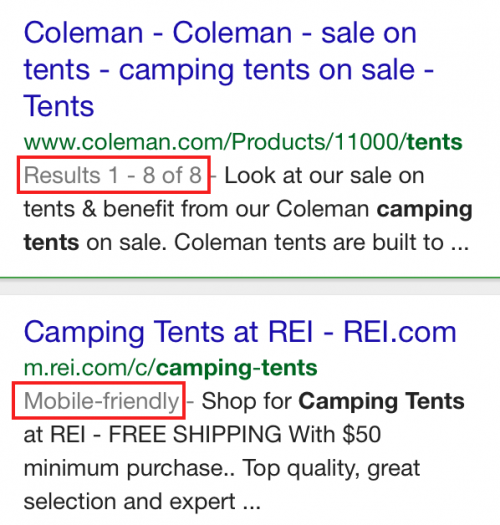
In a Google mobile SERP for the query “camping tents,” some results get the mobile-friendly annotation while other results show the number of products on the page.
You might think the first page isn’t mobile-friendly, but it is:

The results of a Google Mobile-Friendly Test for the tents category page on Coleman.com. (Click to enlarge.)
This issue with the missing mobile-friendly annotation is happening on many category type pages with product listings. Interestingly, this doesn’t seem to be an issue with product review information, where both rating reviews and the mobile-friendly label are displayed.
Another example we can point to is the Target.com mobile site. A search for “target coffee makers” shows the store’s coffee makers page without the mobile-friendly annotation:
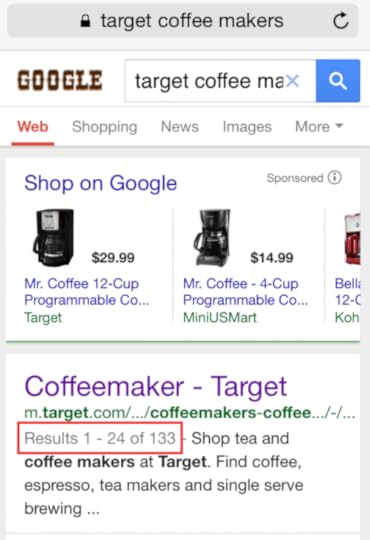
A mobile SERP listing for Target’s mobile site shows the number of results on the page rather than the mobile-friendly annotation.
But this page does pass as mobile-friendly on the Mobile-Friendly Test. Again, the “Results 1 – #” annotation is shown where “mobile-friendly” might instead.
So What’s Happening?
Earlier this week we got word that Maile Ohye from the Google Developer Programs team points to on-page markup as the cause of the issue — including pagination for results, as seen on the example pages shared in this post.
[image error]
From Grant’s comment on a StoneTemple.com post highlighting the missing annotations, it looks like pagination markup, video thumbnail markup and “jump to app” markup get priority over the mobile-friendly annotation. Under the current order of annotation priorities, SEOs and site owners scrambling to make their sites mobile-friendly may not be getting the full benefit of their efforts. Let’s hope that the talks behind Google’s closed doors do ultimately result in a reordering of the annotations displayed.
Have you seen any problems with the mobile-friendly label not appearing in Google SERPs? Would you rather Google prioritize the mobile-friendly annotation over other labels? Let us know in the comments below.
April 13, 2015
Creating Content for a Boring Industry? No Problem
Creating Content for a Boring Industry? No Problem was originally published on BruceClay.com, home of expert search engine optimization tips.
In digital marketing, we talk a lot about content. Emphasizing the importance of quality content and then sharing our tips, tricks and the latest tactics can make content writing seem exciting and sexy. But the truth is, some topics and industries just feel boring. As a writer or the person in charge of writers, how can you turn boring subjects into good content?
Back in February, I spoke at the SEJ Summit in Santa Monica about this very subject, the creation of engaging content marketing for boring industries. It’s something I know all too well, as I got my start in this industry as a writer. I wrote on everything from LED billboards to personal injury to self-storage units. I remember what it was like to listen to fantastic presenters talk about the magic of writing great content. Then I would go back home, sit in front of my laptop, and the reality would hit me again — my topics were b-o-r-i-n-g, or at least they were to me.
3 Takeaways for Writers
The presentation format at the SEJ Summit required each speaker to give the audience three takeaways. While it was a challenge to boil this topic down to three actionable takeaways when I could probably come up with a hundred or more, I picked the top ones that worked for me when I was writing content and then later managing writers: develop real-life stories, keep your eyes open for inspiration, and focus on being practical and personal. You can see the full presentation here:
If your subject matter is dull as a doorknob, follow the tips below.
1. Develop Real-Life Stories
The book “Think Like a Freak” does a great job describing the power of stories:
“Why are stories so valuable? One reason is that a story exerts a power beyond the obvious. The whole is so much greater than the sum of the parts—the facts, the events, the context—that a story creates a deep resonance” (Levitt & Dubner, 2014).
Storytelling has been around forever and it works. I recently had someone on Twitter comment to me that storytelling is so overrated. I couldn’t disagree more. His point was that consumers want to be heard. There is no reason you can’t listen to consumers and also tell them stories. We eventually saw eye to eye on that point.
When you recall a presentation you heard, what will likely stand out the most in your mind is the story used, if there was one. I demonstrated this fact at the SEJ Summit by starting my point about developing real-life stories with one of my own personal and somewhat embarrassing stories (something about rats and my car, but let’s just move on). It caught everyone’s attention and from the feedback I received, it was memorable.
We love stories. They entertain, teach and demonstrate our points. From a writer’s perspective, when you tell your readers a story, they will start to project themselves onto the character. It’s human nature. They will think to themselves, “That’s how I would feel too” or “I would have done the same thing.”
If you are creating content for a business, develop stories that illustrate how customers have successfully used your product or service. Focus on their initial problem that was then solved by your company. Think of it as a testimonial, but instead of a snippet of information, it is the full picture.
2. Keep Your Eyes Open for Inspiration
I explicitly remember one afternoon several years ago when I was under a tight deadline. I had to produce two articles for a company that contracted me to write. It felt like I spent hours sitting in front of the blank computer screen and trying to come up with something to write that was unique and interesting. It’s a horrible feeling. Eventually, I figured out how to overcome my writer’s block.
Preparing ahead of time is one of the keys to getting rid of writer’s block. I used to keep a file in my desk labeled “Content Topics.” Anytime I would come across a newspaper article, magazine feature or any other content I found remotely interesting, I would store it in my file. I would reexamine every piece of content and ask myself if there was some type of angle or insight I could provide my audience. My Content Topics file is also something I used to advise the team of writers I managed years ago. Sometimes it was a matter of reshaping concepts and ideas into something new that was more relevant to the intended readers.
There are many sources of inspiration you can draw from. Several of my favorites include newspapers, magazines, social networks, blog comments and even junk mail (some of that junk mail is intriguing and can inspire you!). Of course, there is a wealth of other inspiration available online from Google Trends, BuzzFeed, Buzzsumo and Addict-o-matic.
3. Focus on Being Practical and Personal

Bring boring subjects to life by making them practical and personal.
Whether you are writing on a subject that you consider boring or not, it’s critical that you include points in your content that make it personal, but also practical, to the reader. For example, instead of just writing a “how to” or other type of piece that gives advice, explain how readers can fit the information into their lives. Where do they go? How should they buy? Is it something they can implement right away? Think about these things and spend careful attention on how you are presenting your message in order to make it practical.
Also, consider the concerns your readers might have as they are searching online. How can you make it simple for them to find help? You will want to determine what possible questions they might have too, as those are all potential topics for you to write about. Before you type one word, close your eyes and imagine what it would be like to be the reader. Spend at least five minutes to get in the right mindset, as doing so will help you empathize with the reader and create compelling content.
If your business offers a product or service that can solve their problems, use it as a call to action, but make it easy for the readers to take advantage of it.
One More Thing
When I gave my presentation at the SEJ Summit, I finished with one last point — no topic is truly boring. What might have been boring to me previously, such as rodent removal or extermination, all of a sudden becomes a very interesting topic when I am battling giant tree rats in my attic or car. I don’t know about you, but when I am faced with a new problem, I start to notice possible solutions all around me. I read articles I never thought I would read, because the boring topic is no longer boring to me.
For more great content marketing tips, be sure to check out the book Content Marketing Strategies for Professionals, by Bruce Clay and Murray Newlands.
April 9, 2015
15 Content Writer Interview Questions You Need to Ask
15 Content Writer Interview Questions You Need to Ask was originally published on BruceClay.com, home of expert search engine optimization tips.
The Internet runs on content. One of the best investments a business can make is hiring an in-house writer tasked with being the voice of the brand online. Content is critical to successful digital marketing, and with algorithm updates like Panda and Hummingbird, it’s clear Google agrees. That’s why many brands and businesses hire full-time, in-house content writers. There’s no denying a qualified content writer can take your digital marketing to the next level. As a testament, Bruce Clay, Inc. has four full-time writers on staff.
“Think of everything that could be made better with refinement by a professional writer. There’s the website and blog, email marketing, everything social media from posts and profiles to customer service and reputation management, marketing collateral including white papers, downloads, press releases, and the kinds of creative content marketing pieces that are the currency of social media today,” said Virginia Nussey, the content and media manager here at Bruce Clay, Inc.
“The reason you want this person on your own payroll and in your office with the rest of the team is because your in-house writer must be empowered to speak on behalf of your business — at least publicly after some behind-the-scenes research and interviews with customer service and technical staff,” Virginia explains. “He or she will master your business, your brand voice, your products, your expertise, your customers, and your customers’ pain points. Maybe you never considered what a writer could do for your business. Certainly, extension of voice and overall polish can be hard to quantify, but in the online content economy, I recommend that businesses of all sizes add a dedicated content professional to their team.”
Not just anyone can type out the next Great American Blog Post. Finding the right content writer is a challenge. Make sure they’re educated (we’ve found a degree in English, communications or journalism prepares someone for this kind of work) and experienced (ask for their three best writing samples). The following questions pulled directly from Bruce Clay, Inc. interviews are great questions to ask during your content writer interview. Questions like these give you a full picture of your prospective writer’s skills.
15 Content Writer Interview Questions
What are your current writing projects?
How do you manage deadlines and priorities?
How much do you write about our industry?
How do you handle writing about “boring” topics?
How do you capture a brand’s voice?
What is your experience with community management and social media?
What are some of your favorite social media tools?
What is your experience with analytics, metrics and tracking content success?
How do you make content SEO-friendly?
What is your approach to keyword research?
What is your experience in technical writing?
How do you research a target audience?
What is your experience with non-text content (images, infographics, etc.)?
Are you familiar with the Penguin and Hummingbird algorithm updates? How did they affect your content strategy?
What do you know about our company?
Have you considered the advantages of bringing a content writer to the team? Is anything stopping you? Share your thoughts and questions on in-house content writers in the comments.
April 7, 2015
Introducing SEOToolSet Lite: A Free SEO Tools Suite
Introducing SEOToolSet Lite: A Free SEO Tools Suite was originally published on BruceClay.com, home of expert search engine optimization tips.
You may have heard of the SEOToolSet®. SEOs have been using it for technical and organic search engine optimization since 1997.
But have you heard of the free SEOToolSet — SEOToolSet Lite?
In March we rolled out the newest generation of the SEOToolSet, built from the ground up and full of new tools our SEO analysts asked for and vetted. SEOToolSet 6 has two tiers — Lite and Pro, and today we want to introduce you to the tools available to you for free in SEOToolSet Lite. There’s no credit card required to sign up for SEOToolSet Lite, and there’s no software to download. Just create a username and password, supply an email, and get instant access to four diagnostic tools for a single website project.
About the Tools in SEOToolSet Lite
Here are the tools you can use on your website project for free in SEOToolSet Lite.
1. The Single Page Analyzer (SPA) is the most used tool in the SEOToolSet and has been historically because our analysts and subscribers find it to be the most comprehensive on-page content analysis tool on the market. The full-featured version of this powerful content analysis tool is now available for free with the release of SEOToolSet 6. The SPA thoroughly analyzes the on-page optimization of your web pages and HTML files, one at a time. It’s an excellent tool if you’re looking to analyze keyword usage and distribution; the strength of meta tags, headings and anchor text; content readability; potential cloaking issues; and much more.
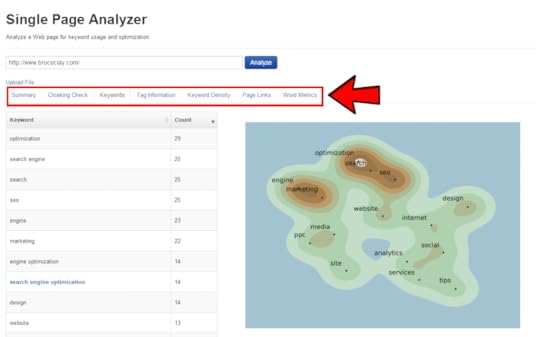
Run the Single Page Analyzer on your URL or your competitor’s and you’ll get reporting of keyword use, tags present, cloaking in place, links to a page, readability analysis, and a visualization of keywords on the page seen as a topographical map. Click to enlarge.
Here’s one new feature of SPA in SEOToolSet 6. Within the Single Page Analyzer you’ll find a content score that helps you gauge the quality, accessibility, and optimization of your content, benchmark a starting point, and measure improvement.

Click to enlarge.
2. A Link Graph that can expose the strength or weakness of your website’s internal linking, organization and silo structure in a visual diagram. Plug in a URL of your website and see the web of links that follow from that page to make sure you’re strategically linking within themes and linking to your site’s key pages.
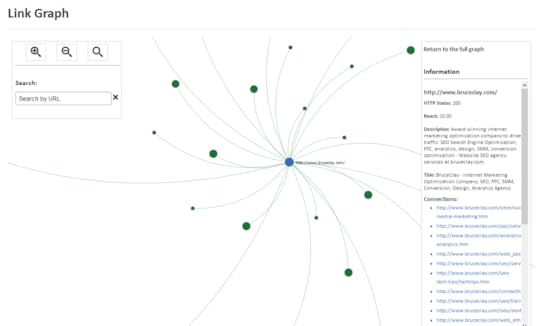
Click to enlarge.
3. A Meta Details report that lets you analyze all the titles, meta tags, H1 tags and canonical tags used throughout your website in one place.

Click to enlarge.
4. A Site Checker that analyzes your server header, checks for user-agent cloaking, looks for follows and redirects, and exposes technical performance issues. In the Site Checker report you will also see your robots.txt file displayed. This technical SEO tool can be referenced during routine site maintenance checks, or used to examine the health of your competitor’s website during the competitive research process.

Click to enlarge.
New Project Dashboard
Also included in the SEOToolSet Lite suite is an intuitive dashboard that shows recent project activity, and allows multiple users to contribute to projects through the single interface. For both SEOToolSet Lite and Pro, projects allow for an unlimited number of users.

Click to enlarge.
How to Access the Tools
Accessing the SEOToolSet Lite suite of tools is an easy process. Sign up for SEOToolSet Lite with your email address and log in. Once in your SEOToolSet Lite account, you’ll be asked to start a new project. Your project is the primary website you would like to analyze.

Click to enlarge.
With your project created, you’re ready to start using the keyword research, site analysis, and page analysis tools! With a free Lite account, you will only be allowed to work with one project at a time, but you will be able to analyze an unlimited number of your own web pages, and the web pages of your competitors, using the Single Page Analyzer tool and the other tools in SEOToolSet Lite.

Click to enlarge.
Want More Power Tools?
The SEOToolSet is a suite of optimization tools created by SEOs for SEOs — and SEOToolSet Lite is the tip of the iceberg. Try SEOToolSet Lite for free, then if you like what you see in SEOToolSet Lite, check out our full professional tool suite designed for the needs of our own SEO analysts, SEOToolSet Pro.
Learn more by comparing the features of SEOToolSet Lite and Pro or dive right in to try SEOToolSet lite hands-on for free. There’s no credit card required, no software to download and no strings attached.
Happy optimizing!
March 30, 2015
Oh, the Challenges SEO Tools Can Solve – Announcing SEOToolSet 6
Oh, the Challenges SEO Tools Can Solve – Announcing SEOToolSet 6 was originally published on BruceClay.com, home of expert search engine optimization tips.
The SEOToolSet® is a suite of organic optimization tools built by SEOs, for SEOs. We created these SEO tools to help us do our jobs better and we hope, in turn, they can help you do your job better, too.
Today we’re launching SEOToolSet 6, the sixth generation of our tools. From the first-ever web page analysis program that Bruce Clay himself wrote in 1997 until now, our SEO software has always had a singular goal: Give SEOs the tools they need to increase a website’s visibility in search.
The SEOToolSet is unique because it focuses entirely on search engine optimization. These tools are for advanced SEOs and marketers who want exportable, in-depth data and presentation-quality reports regarding on-page and off-page optimization. We say the SEOToolSet is “the deepest dive into SEO data available on the market.” These tools help solve the challenges SEOs face every day.
I sat down with our SEO analysts to find out what I should say here to get you as excited about the usefulness of these tools as we are. To get you acquainted with how we’re using the SEOToolSet every day to serve our clients, we came up with three challenges to spotlight. There are so many more power tools in SEOToolSet 6, consider this merely a taste of what’s offered for the advanced SEO.
Challenge 1: Prove SEO progress with reports that monitor objective rankings.
Challenge 2: Figure out what’s “natural” among top-ranked competitors.
Challenge 3: Efficiently find missing meta tags, duplicate titles, and problems with canonical elements.
Challenge 1: Prove SEO progress with reports that monitor objective rankings
SEO is a long-range proposition. It can take a long time to see results, and clients or bosses (depending on who writes your paycheck) can grow impatient waiting for results. While webmaster tools and analytics can show you traffic increases and revenue growth, it’s helpful to have a way to monitor your site’s rise to prominence in the search engine results pages (SERPs) in an objective way.
Solution: The Ranking Monitor
The Ranking Monitor is one of the SEOToolSet’s most powerful tools. Using authorized APIs, the monitor grabs unbiased, non-personalized rankings for lists of keywords — across Google, Yahoo and Bing and for dozens of markets around the world. Because we want to see for ourselves whether pages are moving up or down the SERPs, we built the monitor to run on a schedule, store historical ranking data to watch progress over time, and also keep track of competitor rankings to use for research or comparison.
The data can be exported as CSV (to work in Excel). We also output print-quality Domain Ranking reports to send regularly to our SEO services clients, showing ranking changes either by market, page, keyword or competitor.

What’s new and cool about Ranking Monitor reports: Whenever some hotshot new competitor comes onto your radar, the Ranking Monitor in Version 6 lets you add the new competitor along with its past rankings for your keywords retroactively. So even though you just realized they’re a threat, you can include their history in your stored competitor data as if you’ve been watching them all along.

Click to enlarge.
Challenge 2: Figure out what’s “natural” among top-ranked competitors
On-page optimization requires understanding what the search engines find most relevant. It would be easy if there were hard and fast rules to follow, but every keyword query waves the starting flag for a SERP contest that’s unique unto itself. To know how to best optimize a web page, SEOs have to look at the sites that are ranking to see what Google is currently rewarding.
This is not so easy, either. No one can stare at a web page and mathematically figure out its word count, frequently used words, keyword placement, content reading level and so on. Moreover, to find what’s natural among all the top-ranked sites, you’d have to do this analysis across many pages. We need SEO tools for this kind of thing from beginning to end.
Solution: The Multi Page Analyzer
SEOToolSet 6 lets you discover what’s natural for a keyword in three quick steps:
Pull up the unbiased top-ranking web pages for any keyword or phrase using the Research Summary tool.
Choose the pages you want to analyze (the top five are checked by default, but you can select any you want).
Run the Multi Page Analyzer tool to see data about each of the top-ranked sites as well as combined statistics.
The statistical recommendations reveal where the sweet spot is for all kinds of on-page attributes, including the average length and keyword usage in the title, meta tags, heading, alt attributes and overall body section, as well as the average content reading level, among the top-ranked sites.

Click to enlarge.
What’s cool and new in the MPA: This SEO report was improved in Version 6 to handle more URLs — not just 5, but 10, 15 or as many as you want! The ability to analyze many competing pages at once can make the resulting information extra accurate.
Challenge 3: Efficiently find missing meta tags, duplicate titles, and canonical elements
Our SEO analysts wanted a way to quickly look throughout a website to find missing or incorrect elements — pages with no title, meta description, or Heading 1, for example. The SEOs also asked for a way to search for any snippet of text to find where it appears in meta information sitewide, to avoid duplication. And for ecommerce sites and others, they needed a way to review canonical link elements and locate inconsistencies.
Solution: SEOToolSet 6’s proprietary site spider
The site spider crawls a website automatically, just as the search engines do. For SEOToolSet Pro subscribers, that gives you almost complete crawl data for your site — down to five clicks deep. The various reports produced by the site spider are custom-designed to give SEOs their dream data.
One of those dream reports, called the Meta Details tool, lets you:
Sort by any column so you can easily identify missing or duplicated titles, meta descriptions, meta keywords, Heading 1 tags, URLs or canonical elements.
Search for text in any of these important page elements sitewide.
Export the data as CSV.

Click to enlarge.
What’s exciting and new: The rich data that the site spider collects fuels some other power tools, as well. One is the new Link Graph, which has all of our analysts buzzing. This tool lets you see the site’s linking strategy as an interactive, visual link map. Use this to confirm your site’s link architecture and siloing strategy at a glance.

Click to enlarge.
Ready to try some new SEO tools?
I hope you’ve seen enough to know that these tools are created by SEOs, so they might work to solve some of your challenges, too. There are many more tools than the few I’ve sampled in this article. An SEOToolSet Pro subscription also includes tools and reports for link analysis, keyword research, competitor research and technical site errors, to name a few.
It’s easy and risk-free to sign up for SEOToolSet Pro. I encourage you to try these power tools out on your own site. If you decide you don’t need this much data, cancel within 30 days and we’ll refund your subscription fee entirely. After that, you pay as you go. For $89/month you can run two website projects with an unlimited number of users. If you need to optimize more sites, additional projects cost just $30/month per website. And you can cancel your subscription to our SEO power tools anytime.
Want more details? See our SEOToolSet Features page. Then try it out and let me know what you think.
March 27, 2015
Apps: The New SEO Frontier?
Apps: The New SEO Frontier? was originally published on BruceClay.com, home of expert search engine optimization tips.
On Feb. 26, Google announced it would “surface content from indexed apps more prominently in search.” This announcement brings up an important question for digital marketers: are apps the new SEO frontier?
Did Someone Say Ranking Boost?
 Google’s Feb. 26 announcement that the search engine will now “surface content from indexed apps more prominently in search” is significant news for SEOs. If a user has downloaded your app, your app content can get a ranking boost in their SERP — and if a ranking boost is on the table, it definitely makes an SEO stop and consider the possibilities.
Google’s Feb. 26 announcement that the search engine will now “surface content from indexed apps more prominently in search” is significant news for SEOs. If a user has downloaded your app, your app content can get a ranking boost in their SERP — and if a ranking boost is on the table, it definitely makes an SEO stop and consider the possibilities.
On average, people install 26 apps on their phone … but there are more than 1.3 million apps in the app store. And we know that 5 percent of apps drive 92 percent of all app downloads. Moral of the story? Apps are a very competitive space, and before any coding begins, it’s important to determine whether or not an app is worth the investment for your business.
Last week, Bruce Clay, Inc. hosted the weekly #SEOchat on Twitter to discuss this very topic. Digital marketers had a roundtable discussion about important app matters, including:
What Makes Someone Download an App?
There are many reasons a user might download an app. Chief among them, according to SEO-chatters, are:
The user gets something for downloading it — a coupon, a discount, etc. (Starbucks, Delta, Macy’s, Target).
The app solves a problem or makes life easier for the user.
The app is a better experience than the mobile site.
The app provides entertainment.
The app boosts productivity.
The Current Effect of Deep Linking
Igal Stolpner, head of marketing Investing.com, has already enabled deep linking on an app. (Deep linking is necessary for app indexation). We asked if he’d seen a ranking boost, and he had this to say:
@BruceClayInc a very slight increase, nothing drastic. In the photo – sessions from Google to the app. #Seochat pic.twitter.com/NpVUfkDzaH
— Igal Stolpner (@igalst) March 26, 2015
While Stolpner is right — there is a very slight increase — it’s hard to say that this was, in fact, a boost from deep linking. The slight increase could be attributed to a variety of factors.
The lack of clear ranking boost evidence is consistent with what we’ve seen in our own clients at Bruce Clay, Inc. We have not seen any apps changing rank in the SERP (yet?).
In any event, deep linking should be implemented for all apps. Learn more about indexing your app in this Google Code Lab.
App Store Optimization
The conversation touched on app store optimization. Matthew Young, a senior SEO specialist at Adobe, advised app developers to consider SEO 101 items: “Optimize the titles and descriptions with keywords, use video and images. Also, linking to the app listing in Google and/or Apple is a good thing, as well,” he tweeted.
Other participants advocated garnering reviews and having clear screenshots showing what the app will look like when you use it.
The Effect of Wearables on Apps
When asked how wearables will change the way apps are used and developed, Chad Lio (digitial marketing manager at Massage Magazine) said that he could see a future where developers make two versions of an app: one for mobile and one for wearables.
The development of wearables, of course, depends on an industry’s demand. All parties agreed that the space where apps for wearables is destined to skyrocket is fitness and health.
Read the entire transcript of the March 26 #SEOchat on “Apps: The New SEO Frontier.” You can also hear Bruce Clay’s thoughts on apps in this SEM Synergy podcast.
Have you seen a ranking boost from deep linking? Share your insights (or questions) in the comments!
March 18, 2015
How to Configure a Custom 404 Error Page (Apache Server Edition)
How to Configure a Custom 404 Error Page (Apache Server Edition) was originally published on BruceClay.com, home of expert search engine optimization tips.
A 404 File Not Found page – also known as a 404 error page – is a web page that lets a user know when the page they are trying to access cannot be located. A custom 404 error page is a 404 error page that is crafted thoughtfully with user experience in mind. Custom 404 error pages are put into place to fend off confusion, explain the situation, and offer thoughtful next steps that keep the ball rolling.
To get a custom 404 error page up and running on your website, you’ll need to do some communicating with your server.

An example of a custom 404 error page.
How you go about getting a custom 404 error page setup on your server will vary greatly depending on your server type. This article addresses how to set up a custom 404 error page on an Apache server.
Getting a custom 404 error page up and running on the Apache Server is a five-part process:
Design an on-brand custom 404 error page.
Publish your custom 404 error page.
Determine what type of server you are using, or if you are using a CMS like WordPress.
Use your public_html folder and .htaccess file to tell your server to deliver the 404 error page anytime a request is made for a web page that doesn’t exist.
Test it! Make sure your 404 error page is live and working as expected.
In this post we cover parts 3, 4 and 5 of this process; you should already have parts 1 and 2 done. If you haven’t designed your custom 404 error page yet, read How to Design a 404 Error Page That Saves a Sale for strategic inspiration.
How to Determine Your Server Type
Your website is hosted on a server that dishes out web pages when people navigate to URLs within your domain. There are several types of servers.
 First, the easiest one: If you are using WordPress, you know you’re using WordPress and you should read about WordPress 404 error page setup; this Apache server article will not help you.
First, the easiest one: If you are using WordPress, you know you’re using WordPress and you should read about WordPress 404 error page setup; this Apache server article will not help you.
If you aren’t using WordPress and you don’t know what kind of server you are using, call your server provider (the people you pay to host your website every month – like BlueHost, for instance), and ask them. While you have them on the line, make sure to also ask them if it is possible to set up a custom 404 error page; most server providers allow you to do this, but not all.
If your server provider tells you your website is hosted on the most widely used Web server — the Apache server — read on!
Proceed With Caution!
If you are reading this blog post, I am assuming that you don’t have the luxury of asking an IT department to set your custom 404 error page up for you. If you do have an IT/systems department to refer to, by all means, ask for help! IT folks love servers and lines of code that talk to servers, and they effectively know how to handle both.
If you’re going in on your own, it’s smart to make sure you have your entire website backed up before you make any changes to code at the server level. The amendments we’ll be making to add a custom 404 error page are minimal, but it’s always better to be safe than sorry when it comes to tinkering with server-side code.
How to Tell Your Server to Deliver the 404 Error Page
This blog post is written to help folks using the Apache server add a custom 404 error page to their website. Like most processes, there’s inherently  more than one way to do this. The following five-step process is the most universal method, as it only requires FTP access to your server and a text editor, like Notepad++ (on a PC) or TextEdit (on a Mac). (It’s worth mentioning here that Notepad [the default text editor in Windows] and Notepad++ are not the same thing. If you’re using a PC, we recommend downloading the free Notepad++ text editor; using the standard release version of Notepad may cause errors if the server is running Linux.)
more than one way to do this. The following five-step process is the most universal method, as it only requires FTP access to your server and a text editor, like Notepad++ (on a PC) or TextEdit (on a Mac). (It’s worth mentioning here that Notepad [the default text editor in Windows] and Notepad++ are not the same thing. If you’re using a PC, we recommend downloading the free Notepad++ text editor; using the standard release version of Notepad may cause errors if the server is running Linux.)
Step One: Locate or create your .htaccess file
After identifying that you are using the Apache server, the first step is to locate your .htaccess file.
A .htaccess file is a file that communicates how and when your server should deliver specific information to your end user. In this case, specifically, when your server should deliver a fancy, custom-made 404 error page. Your .htaccess file should already be in the root directory of your website.
To access your .htaccess file:
Connect to your server using an FTP editor like CyberDuck or Filezilla.
Find the folder that contains your public website files. Public_html is a common name for this folder. While your folder may or may not be named public_html, we will refer to this folder as the public_html folder throughout the rest of this tutorial.
Locate the .htaccess file inside the public_html folder.
If you see a .htaccess file, move on to step three.

Use your FTP client to locate your .htaccess file. It should be in the folder where you keep all your public website files.
If you don’t see a .htaccess file, make sure that your FTP is set to show hidden files (notice that period in front of the .htaccess file? That period means your .htaccess file it is a hidden file.). To show hidden files using Cyberduck, go to the View dropdown, then choose Show Hidden Files. To show hidden files using Filezilla, go to the Server dropdown, then choose Force Showing Hidden Files.

Show hidden files in Cyberduck using the View dropdown menu, as seen here.
If you force your FTP to show hidden files and you still don’t see a .htaccess file, it means you don’t have one and you will have to make one. In that case, move on to step two.
Step Two: Create your .htaccess file (if you don’t already have one)
Fair warning: While any novice can create a .htaccess file (we’re going to show you how right here!), if you have an IT department this is a really, really good time to bring them in the loop. If you don’t have an IT department, now would be a great time to create that website backup if you haven’t already! Your .htaccess file is going to communicate critical information to every page of your website, so it’s smart to have a backup plan in case things get a little haywire.
To create an .htaccess file, use a text editor like Notepad++ on a PC, or TextEdit on a Mac. Name the file .htaccess — and don’t forget the “.” It needs to be named .htaccess (periodhtaccess), not just htaccess. To keep your .htaccess file clean, make sure your text editor has word wrap disabled, and that it is using UNIX-style line endings. Also, make sure there aren’t any file extensions added to your .htaccess file when you save it. You want to choose All Files (not Text or any other file type) from the Save As Type dropdown menu and save to the Desktop.
That’s it! After you save you’re done creating your .htaccess file. The file won’t do anything until you’ve uploaded it to the public_html folder of your server via FTP but, to streamline the process, we’ll wait until after we amend the file (as outlined in step three) to upload it to the server.
Step Three: Use a text editor to edit the .htaccess file
Using your text editor, add this one line of code to your .htaccess file, followed by a blank line:
ErrorDocument 404 http://www.YourWebsite.com/Custom-404...
There’s four parts to this line of code: [the phrase ErrorDocument] [the error number] [the absolute URL of the web page where custom 404 content lives] [the blank line that follows the line of code]. Make sure you carefully include all four elements (No typos! No exclusions!) and make sure you replace the placeholder “YourWebsite.com” URL with the actual URL where your custom 404 error page lives.
It’s this one line of code that tells your .htaccess file to deliver a custom 404 page when someone asks for a web page that cannot be located.
Step Four: Use FTP to upload your amended .htaccess file to your server
Make your .htaccess file alliiivvvveeee (like Frankenstein) by using your FTP to upload your amended file to your server.
Once it’s uploaded to the root directory of your server, it’s live and your 404 error page should be working (assuming you’ve made your 404 error URL live, as well).
Step Five: Test it! Make sure your 404 error page is working
The final step in every optimization process needs to be testing. We never set it and forget it in our industry. To test if everything is in working order  with your .htaccess file and your new custom 404 error page, use your web browser to navigate to a page on your website that you know doesn’t exist. For example: www.YourWebsite.com/chelsea-is-awesome.
with your .htaccess file and your new custom 404 error page, use your web browser to navigate to a page on your website that you know doesn’t exist. For example: www.YourWebsite.com/chelsea-is-awesome.
If you see your custom 404 error page, everything is working! You have succeeded!
If you don’t see your custom 404 error page, something is wrong. Try to isolate the problem with these troubleshooting tips:
Do all the other pages on your website work? If yes, that means the problem has to be with your 404 error page URL or your .htaccess file. If no, you have created a bigger issue and may want to revert back to a backup version of your .htaccess file.
Can you spot any typos in your ErrorDocument line of code?
Did you add a blank line after your ErrorDocument line of code?
Did you disable word wrap when you created your .htaccess file? Is your ErrorDocument code on one single line? If you are using Windows, is the document using UNIX-style line endings?
Is your .htaccess file saved as .htaccess.txt? It shouldn’t be. It should just be .htaccess with no file extension. (The trick is to choose All Files from the Save as Type dropdown when you save the file in your text editor; make sure no extra file extensions get added on.)
If you navigate directly to your 404 error page using the absolute URL, does it work?
If none of these troubleshooting tips uncover your problem… now might be a good time to seriously consider hiring that contract IT guy or gal.
You Can Do This!
Even if you are a UX minimalist — no matter how big or small your company is — you need to consider a properly configured 404 error page a technical SEO essential. You absolutely can do all the steps outlined in this post, from locating your hidden .htaccess file or creating a new one, to writing a line of code that works. Think of it like baking a cake: you have the recipe, now you just need to put all the ingredients together.
Just follow this five-step process:
1. Get confirmation that you’re using the Apache server and the thumbs up to proceed with a custom 404 from your server host.
2. Work with your web designer to create a custom 404 error page.
3. Make your 404 error page live.
4. Use your public_html folder and .htaccess file to tell your server to deliver the 404 error page anytime a request is made for a web page that doesn’t exist.
5. Test, test, test.
Have questions? Ask in the comments section below.

Learn more about servers and how to get your web pages found, crawled and indexed with these technical SEO tips.
March 12, 2015
Two Power Players Talk SEO & Social: Bruce Clay and David Amerland’s Video HOA
Two Power Players Talk SEO & Social: Bruce Clay and David Amerland’s Video HOA was originally published on BruceClay.com, home of expert search engine optimization tips.

Bruce Clay shared his marketing insights on SEO, branding and social media yesterday on “Social Media Today Power Talk,” a monthly digital marketing show hosted by David Amerland. Amerland is the author of many digital marketing books, including “SEO Help: 20 Semantic Search Steps,” “Google Semantic Search,” and “Google+ Hangouts for Business,” and a stand-out Google+ influencer with more than 350K followers. Bruce was honored to be a guest on this lively episode of Social Media Power Talk, which you can relive complete with comments on the event page here.
Watch the entire show above or read on for select highlights, including Bruce’s thoughts on:
The Evolution of SEO
Why Some People Think SEO is Dead
The Necessity of Planning 2-5 Years Ahead
The Cube Theory
Making Your Team Work as a Team
The Effect of Social Buzz on Ranking
The Evolution of the SEO
Amerland asks Bruce why it is that people persist with asking “Is SEO dead?” Bruce explained that it’s because SEO is dead — at least in a sense.
“In the beginning SEO was rather simple — you optimized a page, got some links and you would rank. Up until seven years ago, SEO was not as complex as it is today. I’ve actually said SEO is dead as it was. It has evolved. Today’s SEO is not like the SEO of ten years ago, or five years ago, or two years. What goes into SEO today is far more technical, it is more far-reaching, it has much more visibility and more people think they’re doing SEO than actually are,” Bruce explained.
“In the beginning, many of the people that were doing SEO grew up by being pseudo-programmers. They were doing web design, maybe programming, they were technical, had technical backgrounds, they were editing HTML, etc. The problem is they grew up in that world and never had a marketing course — maybe never even read a marketing book. They don’t really understand personas or communities or any of the things that are now fundamental to proper targeting and understanding who it is that your audience needs to reach and the terminology they use when they do queries. In the beginning, it was just one keyword, edit the page, get some links and you were an SEO. Today it is much broader.”
Why Some People Think SEO is Dead
What did the audience think about the state of SEO? Co-host Alexandra Riecke-Gonzales polled the audience and found that while the majority views SEO as evolving (as Bruce does), ten percent of viewers do, in fact, think SEO is dead.

Bruce weighed in: “I would easily view the ten percent that think SEO is dead are the people that either got burned by it or the only way they thought SEO worked was through links — and links are dead. There are a lot of people who lost faith in SEO because the only SEO they knew was spam. And if spam is dead, then ‘SEO’ is dead,” Bruce said.
What about those who think social media marketing is replacing SEO?
“Social hasn’t replaced SEO and if you look at any attribution model what you’re going to find is that when you do things socially, organic search traffic goes up. It’s the attribution that fails. It’s a stimulus response. Most people think SEO starts when you do the query but from a traffic point-of-view, SEO starts when you plant the seed in their brain to start the query — and social is upstream of the organic query. A lot of people perceive social media marketing, then, as the new SEO — but it’s not. The fact is if that if you don’t rank it doesn’t matter if you trigger them to do a query because you’re not going to get the traffic anyhow. Social media marketing is never going to replace SEO, but it is fully complimentary to SEO,” Bruce explained.

Successful SEOs are Planning 2-5 Years Ahead
“Anyone who’s doing SEO right is looking to the future. You have to imagine search two to five years out because it will take you a year to develop the ability to be two years out. If you can envision what search will look like two years from now, then you know to do it. Two years ago, we anticipated that mobile would conquer the world. We knew that Google would shift its focus from desktop to mobile,” Bruce said. “Forty years ago the world switched from main frame computers to PC, and now people are switching from PC to tablets and mobile.”
The Cube Theory
Bruce: “The proper way of viewing digital marketing for search is to look at it three-dimensionally. There’s a spatial relationship between all the components in a cubed way they all touch each other. As with a cube, they all touch each other. PPC deals with social and SEO, and PPC has landing pages. But you can also imagine that when the web design team redesigns a site, they have to make sure that the SEO is right and the PPC landing pages are still right. They also have to worry about quality score, performance, economic goals and duplicate content. All these various components of a business that has to do with what a user will see are actually a single component. Digital marketing is a single, 3D operating unit. If each side (representing a function) doesn’t communicate and cooperate with the other sides, a business is destined to fail.”
Bruce Clay, Inc. Internal Structure: Education and Teamwork
Bruce explained that everyone that comes through his company has to go through extensive training. “We have a formal training program and a full immersion program. Even when we hire a senior SEO, for the first two months they don’t have projects.”
The Importance of Ongoing Education
In order to be a leader, you have to pay attention to what’s going on out there. We assign about 120 hours a month of actual project work and we’re expect that the other 40 hours a month are spent on education — reading, paying attention, classes, courses, webinars, conferences, etc. We provide our staff sufficient time for them to be knowledgeable on all algorithm changes as they happen.
‘We Make Our Team Work as a Team’
At Bruce Clay, Inc., everyone is involved in projects.
“That isn’t to say that we don’t have people that focus on SEO, people that focus on PPC, people that focus on content and social, etc., but they’re all connected. PPC is thirty feet from SEO and they’re working on the same projects. When we have a call with a client, all the departments are on the call. They hear what the status is, share knowledge, etc. SEO hears what PPC has to say and vice versa. We’ve gone way out our way to make our team work as a team,” Bruce explained.
The Effect of Social Buzz on Ranking
Audience members were curious about social media’s affect on search rankings, especially with the recent announcement that Twitter will be giving Google access to its fire hose. Audience member Cynthia Turcotte asked: “Does this mean that social reach (in particular Twitter reach) is going to become a more significant ranking factor than previously?”
“Yes, no, yes,” Bruce joked. “In the beginning, what was going with the fire hose from Twitter was that Google was picking up links. At the time, they were followed links and that was influencing Google. Spammers figured that out and then ultimately the Twitter interface died off. Now it’s going to come back, but I don’t think Google is going to look at links, but rather buzz. I expect to see that if a site is getting a lot of comments and it’s driving traffic through Twitter, those comments will cause a temporary (24-hour) impact in Google rankings. It will perhaps even promote something up into the first page. This will be a factor of buzz.”
Another audience member, Deborah Norton, asked a follow-up question: “Where do you see Google+ going in the future? Are tweets going to compete with Google+ posts?”
I think that Google is going to experiment. I think we’re going to see tweets show up if they’re very high volume. If they’re medium volume, they’ll have some influence. Tweets will be a minor variable if they’re low traffic — for example, only have three retweets.
I don’t know that Google is going to ever really bring back a Google+ in a social way. It still influences things. Take the author tag, for example. Google said they’re no longer going to be showing it in the search results, and they don’t. Google never said, however, that they’re ignoring it. So, it may be that a lot of these things — Google+, Twitter, etc. — it’s entirely possible that these things influence results, whether or not Google says it is.
Thank you to host David Amerland for inviting Bruce Clay to the show! Get more episodes and further information on “Social Media Today Power Talk” here.


